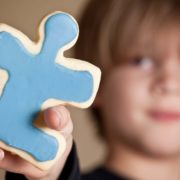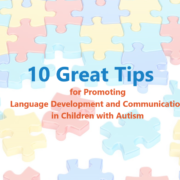Social Pragmatic Disorder vs Autism: What’s the Difference?
Despite similarities, Autism Spectrum Disorder (ASD) is not Social Pragmatic Communication Disorder (SCD). SCD first appeared in the Diagnostic and Statistical Manual in 2013. SCD is a newer discovery and the symptoms of ASD and SCD are similar, even overlapping, yet different.
A person struggling with SCD may have trouble with tones or sharing their thoughts. Speech, nonverbal communication, and social cues are the most common challenges for individuals who have social pragmatic communication disorder.
The best way to support someone who has SCD is with speech-language therapy. Schedule a free introductory call with Great Speech to discuss the challenges you are facing, as well as the best route to overcoming them with our online speech therapy services.
People with SCD will have trouble understanding the meaning of their interactions.
If you suspect someone you love has SCD, keep reading. This article will outline the signs and treatments of SCD. To learn more about it, let’s start with how it gets misdiagnosed.
Diagnosing SCD vs. ASD
There are many ways to separate Social Pragmatic Communication Disorder from autism. Visits to doctors and speech pathologists will be necessary. Hearing tests and other screenings ensure the person is not misdiagnosed.
Individuals with autism will experience symptoms common of SCD and have other symptoms. People with autism repeat certain behaviors and have disruptive behaviors. Individuals with SCD will not display these behaviors. People with SCD struggle to adjust their communication based on the specific situation.
Collecting information from parents, teachers or significant others is an ongoing process. Interviews, questionnaires and personal observations are examples of the type of information needed. A look at family medical history will provide insight in making an assessment.
ASD Specific Behavioral Signs
There are some consistent signs shared among those along the autism spectrum. Here are the most common:
- Twirling, jumping, rocking, flipping the hands, headbanging, and other repetitive behavior.
- Obsession with putting things in order or items having a certain placement.
- Extreme fixation on rituals and routines.
- Repeating of sounds, syllables, words and/or phrases in excess.
- Very preoccupied with specific objects or subjects.
- Odd responses to sensory stimulation, especially sound, and visual chaos.
- Doesn’t take part in pretend or make-believe activity.
SCD Behavioral Signs
In comparison, there are some Social Pragmatic Communication Disorder-specific signs. They differ slightly from ASD, but here are some important distinctions:
- Not responding to people in a way that is understandable.
- Interrupting others during conversation.
- May not use gestures such as waving and pointing.
- Difficulty expressing feelings and emotions.
- Changing the topic or losing track of what is being discussed.
- Difficulty using words as needed to make conversation.
- Trouble making friends and maintaining friendships.
- Delays in speech or language development which can even include disinterest in talking.
Treatment of SCD and ASD
There are many different types of treatment available. Speech and language therapy is very helpful in the treatment of people with either SCD or ASD. While it’s never too late to begin speech therapy, early diagnosis is encouraged as it gives the person a head start.
Whether you have a formal diagnosis or not, at Great Speech, we treat a wide range of speech and language challenges including autism and social communication disorder. Reach out today and schedule a free introductory call to get started in your customized program.
Social Pragmatic Communication Disorder Treatments
Bear in mind many of the treatments for SCD are also helpful in the treatment of ASD. Treatment should focus on improvements in functional communication skills specific to social situations. A focus on the individual’s needs will also need to take precedent.
Develop tools that will be most beneficial in the person’s daily engagements. In some cases, scripts help the person handle common conversations. These can help identify weaknesses and practice overcoming social roadblocks.
Social interactions need encouragement within and outside of observable settings. A therapist can train family members on a variety of strategies to help with engagement.
Involvement of school staff is likely the best route for children. This will ensure practice and feedback in a variety of social situations is taking place. It’s also important to prevent any bullying situations.
Autism Spectrum Disorder Treatments
Trial and error, a great team of people and patience will be necessary to properly treat ASD. There are four categories of treatment when dealing with autism.
Treatment of Behavior and Communication
Approaches that help involve structure, organization, direction, and family participation. Below are some specific treatments.
- Applied Behavior Analysis (ABA) is popular. ABA comes in several forms but generally speaking, involves tracking and measuring behaviors. Promotion of good behavior and discouragement of bad behavior is the general goal.
- Developmental, Individual Differences, Relationship-Based Approach (DIR) or floor time is another form of treatment. DIR focuses on the development of feelings and relationships. It works for peers, caregivers or family. How the child deals with sensory stimulation like smells and sounds is also addressed.
- Occupational Therapy teaches everyday skills. Independence is the goal here. Focus can be on getting better at eating, bathing and understanding others
- Sensory Integration Therapy helps the person handle things like sights, sounds, and smells. This form of therapy is good for people that struggle with touch or noisy environments.
- Speech Therapy helps to improve a person’s communication skills. This therapy will help the person develop the style of communication best suited for them. Some people may be better at using pictures to communicate or gestures rather than words.
Dietary Approaches
Consult a doctor before trying a dietary approach. Methods used include removing foods that contain gluten, milk, soy and/or sugar from the diet. Vitamin supplements fill in any nutritional gaps and can increase cognitive performance.
There isn’t much scientific support for this method, unfortunately.
Medication
There are medicines that can help with some of the symptoms of ASD. Medication that helps with an inability to focus or even high energy levels may be quite helpful. Medicines treating seizures and depression have also been effective.
Complementary and Alternative Medicine
Several treatments falling under this category also fall under dietary approaches. Consult a doctor before beginning any form of alternative medicine or complementary treatment.
Epsom baths, gluten-free diets, and use of natural home products are good practices. These practices have come under controversy because they lack scientific support.
The More You Know
We know this can be a lot to take in. Hopefully, this article has helped with understanding social pragmatic communication disorder and how it differs from autism spectrum disorder. You may have more questions and we’re here to help.
Great Speech’s team of speech-language therapists offer services for a wide range of people, including those related to social pragmatic communication disorder and autism spectrum disorder.
Whatever your needs are, Great Speech has got you covered. Click here to schedule a free introductory call to get matched with a speech therapist, and begin your journey to more confident and effective communication. We look forward to hearing from you.












